Storm Nelson was a character in the eponymous strip in the British comic Eagle .
Storm Nelson was a character in the eponymous strip in the British comic Eagle .
A former officer of the Royal Navy, Commander Nelson owned the ship Silver Spray, part of the Silver Fleet. This fleet included at various times an amphibious motor launch ("Silver Foam") and a helicopter ("Silver Hawk") – all named Silver – as well as a small submarine ("Silver Fish").
Nelson's versatile crew included Jonah McCann from the town of Auchtermuchty in Scotland, the radio operator, Bash Callaghan, who was the pilot of the ship's helicopter, Spanner Dodds, the ship's engineer, and a ship's boy known as Kerfuffle Kidd who was working for his Master's ticket.
The fleet seemed to spend much of its time in the West Indies and the Pacific, visiting islands occupied by ex-British colonial peoples. They righted wrongs and confronted nasty characters who dared to threaten peaceful island communities.
The strip ran from October 1953 to March 1962. It was drawn by Richard Jennings, with scripts for the earlier stories by Guy Morgan (under the pen name Edward Trice), and later Jennings wrote the stories as well.
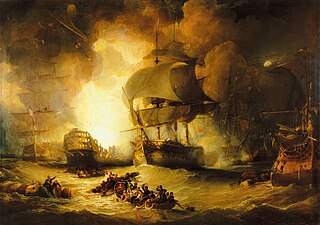
The Battle of the Nile was a major naval battle fought between the British Royal Navy and the Navy of the French Republic at Aboukir Bay on the Mediterranean coast off the Nile Delta of Egypt from the 1st to the 3rd of August 1798. The battle was the climax of a naval campaign that had raged across the Mediterranean during the previous three months, as a large French convoy sailed from Toulon to Alexandria carrying an expeditionary force under General Napoleon Bonaparte. The British fleet was led in the battle by Rear-Admiral Sir Horatio Nelson; they decisively defeated the French under Vice-Admiral François-Paul Brueys d'Aigalliers.

The Battle of Trafalgar was a naval engagement that took place on 21 October 1805 between the British Royal Navy and the combined fleets of the French and Spanish Navies during the War of the Third Coalition of the Napoleonic Wars (1803–1815).

The Battle of Valcour Island, also known as the Battle of Valcour Bay, was a naval engagement that took place on October 11, 1776, on Lake Champlain. The main action took place in Valcour Bay, a narrow strait between the New York mainland and Valcour Island. The battle is generally regarded as one of the first naval battles of the American Revolutionary War, and one of the first fought by the United States Navy. Most of the ships in the American fleet under the command of Benedict Arnold were captured or destroyed by a British force under the overall direction of General Guy Carleton. However, the American defense of Lake Champlain stalled British plans to reach the upper Hudson River valley.
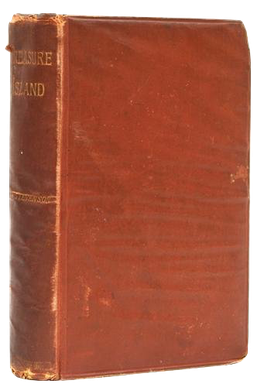
Treasure Island is an adventure novel by Scottish author Robert Louis Stevenson, telling a story of "buccaneers and buried gold". It is considered a coming-of-age story and is noted for its atmosphere, characters, and action.
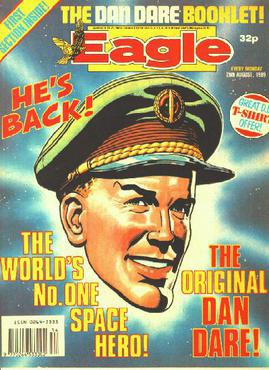
Dan Dare is a British science fiction comic hero, created by illustrator Frank Hampson who also wrote the first stories. Dare appeared in the Eagle comic series Dan Dare, Pilot of the Future from 1950 to 1967, and dramatised seven times a week on Radio Luxembourg (1951–1956).
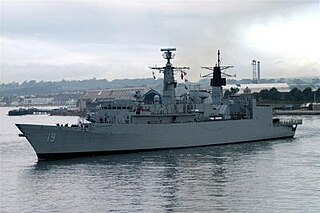
Almirante Williams is a Type 22 frigate in service with the Chilean Navy. It entered service with the British Royal Navy in 1988 with the name HMS Sheffield, and served with the Royal Navy until 2002. Initially it was meant to be called Bruiser, but was named Sheffield in honour of the previous Sheffield, a Type 42 destroyer sunk in the Falklands War. In 2003, the vessel was acquired by the Chilean Navy and renamed Almirante Williams.

A dock landing ship is an amphibious warfare ship with a well dock to transport and launch landing craft and amphibious vehicles. Some ships with well decks, such as the Soviet Ivan Rogov class, also have bow doors to enable them to deliver vehicles directly onto a beach. Modern dock landing ships also operate helicopters.
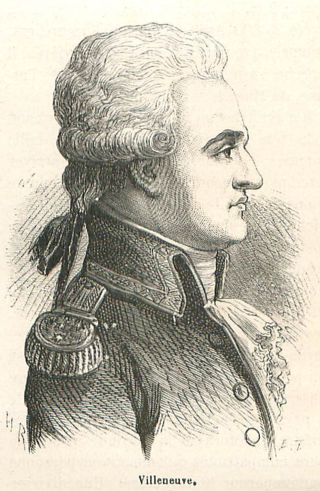
Pierre-Charles-Jean-Baptiste-Silvestre de Villeneuve was a French naval officer during the Napoleonic Wars. He was in command of the French and the Spanish fleets that were defeated by Horatio Nelson at the Battle of Trafalgar.

Admiral Sir John Thomas Duckworth, 1st Baronet, GCB was an English officer of the Royal Navy, serving during the Seven Years' War, the American War of Independence, the French Revolutionary and Napoleonic wars, as the Governor of Newfoundland during the War of 1812, and a member of the British House of Commons during his semi-retirement. Duckworth, a vicar's son, achieved much in a naval career that began at the age of 11.

Charles Vane was an English pirate who operated in the Bahamas during the end of the Golden Age of Piracy.
Urca de Lima is a Spanish shipwreck near Fort Pierce, Florida, United States. She was part of the 1715 Treasure Fleet, one of the numerous Spanish treasure fleets sailing between Spain and its colonies in the Americas. The wreck is located north of Fort Pierce Inlet, 200 yards off the shore from Jack Island Park. It became the first Florida Underwater Archaeological Preserve when dedicated in 1987. This was followed on May 31, 2001 with its addition to the U.S. National Register of Historic Places.

In English-speaking popular culture, the modern pirate stereotype owes its attributes mostly to the imagined tradition of the 18th-century Caribbean pirate sailing off the Spanish Main and to such celebrated 20th-century depictions as Captain Hook and his crew in the theatrical and film versions of J. M. Barrie's children's book Peter Pan, Robert Newton's portrayal of Long John Silver in the 1950 film adaptation of the Robert Louis Stevenson novel Treasure Island, and various adaptations of the Middle Eastern pirate, Sinbad the Sailor. In these and countless other books, films, and legends, pirates are portrayed as "swashbucklers" and "plunderers". They are shown on ships, often wearing eyepatches or peg legs, having a parrot perched on their shoulder, speaking in a West Country accent, and saying phrases like "Arr, matey" and "Avast, me hearty". Pirates have retained their image through pirate-themed tourist attractions, film, toys, books and plays.
Henry Jennings was an English privateer-turned-pirate. Jennings' first recorded act of piracy took place in early 1716 when, with three vessels and 150–300 men, Jennings' fleet ambushed the Spanish salvage camp from the 1715 Treasure Fleet. After the Florida raid, Jennings and his crew also linked up with Benjamin Hornigold's "three sets of pirates" from New Providence Island.

HMS Vidal was a survey ship of the Royal Navy. She was designed specifically as a surveying vessel, and was the first survey ship to carry a helicopter. In 1955, a group from Vidal formally annexed Rockall in the North Sea to the United Kingdom.
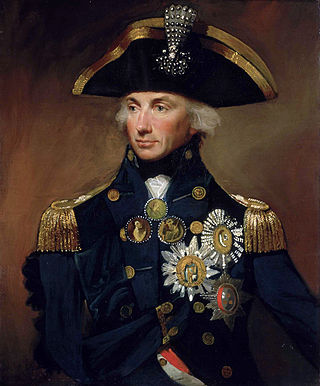
Vice-Admiral Horatio Nelson, 1st Viscount Nelson, 1st Duke of Bronte was a British flag officer in the Royal Navy. His inspirational leadership, grasp of strategy and unconventional tactics brought about a number of decisive British naval victories during the French Revolutionary and Napoleonic Wars. He is widely regarded as one of the greatest naval commanders in history. His victory on 21 October 1805 at the Battle of Trafalgar led to British naval supremacy for over another century and beyond.

The siege of Malta, also known as the siege of Valletta or the French blockade, was a two-year siege and blockade of the French garrison in Valletta and the Three Cities, the largest settlements and main port on the Mediterranean island of Malta, between 1798 and 1800. Malta had been captured by a French expeditionary force during the Mediterranean campaign of 1798, and garrisoned with 3,000 soldiers under the command of Claude-Henri Belgrand de Vaubois. After the British Royal Navy destroyed the French Mediterranean Fleet at the Battle of the Nile on 1 August 1798, the British were able to initiate a blockade of Malta, assisted by an uprising among the native Maltese population against French rule. After its retreat to Valletta, the French garrison faced severe food shortages, exacerbated by the effectiveness of the British blockade. Although small quantities of supplies arrived in early 1799, there was no further traffic until early 1800, by which time starvation and disease were having a disastrous effect on the health, morale, and combat capability of the French troops.
The Battle of Santa Cruz de Tenerife was a minor military action of the War of the Spanish Succession during which an English fleet of 13 ships under the command of Admiral John Jennings attempted unsuccessfully to seize the city of Santa Cruz de Tenerife. Jennings previously relied on the English triumphs in the Iberian Peninsula demanding recognition for the sovereignty of Charles II of England over the Canary Islands, but their offers were rejected.

The Republic of Pirates was the base and stronghold of a loose confederacy run by privateers-turned-pirates in Nassau on New Providence island in the Bahamas during the Golden Age of Piracy for about twelve years from 1706 until 1718. While it was not a republic in a formal sense, it was governed by an informal pirate code, which dictated that the crews of the Republic would vote on the leadership of their ships and treat other pirate crews with civility. The term comes from Colin Woodard's book of the same name.
Samuel Liddell was a pirate, privateer, and merchant active in the Caribbean. He is best known for sailing alongside Henry Jennings.

The Flying Gang was an 18th-century group of pirates who established themselves in Nassau, New Providence in the Bahamas after the destruction of Port Royal in Jamaica. The gang consisted of the most notorious and cunning pirates of the time, and they terrorized and pillaged the Caribbean until the Royal Navy and infighting brought them to justice. They achieved great fame and wealth by raiding salvagers attempting to recover gold from the sunken Spanish treasure fleet. They established their own codes and governed themselves independent from any of the colonial powers of the time. Nassau was deemed the Republic of Pirates as it attracted many former privateers looking for work to its shores. The Governor of Bermuda stated that there were over 1,000 pirates in Nassau at that time and that they outnumbered the mere hundred inhabitants in the town.